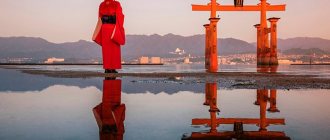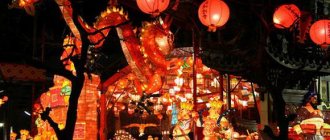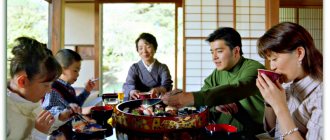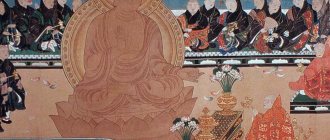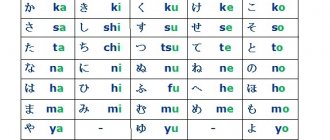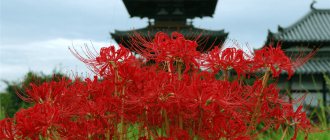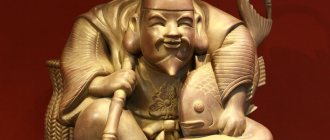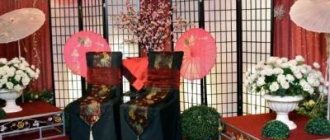Japan is a country of amazing traditions. In Japanese culture, medieval morals are paradoxically combined with a passion for the total use of high technology in all spheres of life. The customs of modern Japanese are built around ancient secular traditions, as well as around two religions - Buddhism and Shintoism (an ancient pagan faith). About 80% of the country's residents claim to profess both religions, which looks strange in the eyes of representatives of other cultures. This is largely why Japanese rituals seem so unusual to foreigners.
The Japanese funeral is perhaps the most unusual of these rituals, as death in Japan is associated with a whole range of traditions and ceremonies.
Preparation for burial
Immediately after death, the body of the deceased is prepared for burial. The lips of the deceased are supposed to be moistened with water, and a special knife is placed on his chest, which is believed to drive away evil spirits. A small table decorated with flowers and a scented candle is placed near the bed of the deceased. If the family of the deceased has a Buddhist or Shinto altar, it is covered with white paper - it is believed that this protects the deceased from evil spirits.
The body of the deceased is washed, after which funeral makeup is applied. Women are usually buried in a kimono, and men in a business suit. The deceased's favorite things and six coins are placed in the coffin. According to legends, the money is the payment for crossing the river of the dead Sanzu.
The reason for the appearance of houses of the dead
Why did the massive construction of vertical necropolises begin? The main motivating factor is the banal lack of space. The country is growing, land on the islands is becoming more expensive every second (the cost of a small plot reaches 100 thousand yen), so underground burials are gradually losing their relevance.
Infectious disease specialist noted increased infectiousness of the new strain of coronavirus for children
Singer Karina Koks remembered her Wolf costume on “Mask”
Meghan Markle is expecting her second child. There will be a new addition to the prince's family
But what about centuries-old traditions, you ask? After all, from time immemorial in Japan it was customary to arrange family crypts in the small homeland, where generations of ancestors lived before. How will the orthodox residents of the state of contrasts react to the controversial innovation?
Funeral service in Japanese
The funeral service is the first ceremonial part of a Japanese funeral. It is usually held in Buddhist temples. If the deceased was a Buddhist, then at the ceremony a Buddhist priest reads sutras, and those bidding farewell come with juju beads. The funeral service ends when the priest finishes reading the sutra.
It is customary to come to a funeral ceremony in strict black clothes. Women wear a black dress or kimono, men a black suit, black tie and white shirt.
Family members sit next to the coffin with the body of the deceased, the rest of the ceremony participants sit at a distance. Everyone present must burn the ceremonial incense three times.
Funeral arrangements
Walk through a high-tech Japanese cemetery
Shinjuku Ruriko Inshiro Rengedo is a site closed to tourists, only relatives of the deceased can enter. The access system is very strict, almost like in a police station. Those wishing to visit their relatives must leave a request on a special website, then pick up a one-time pass at the cemetery reception, which is returned before leaving the building. Taking photographs and videos inside is prohibited; it is believed that this may offend the invisibly present spirits.
On the ground floor of the skyscraper there is a reception desk and a large hall. Here you can see a diagram of the building. It is not just a cemetery, but a full range of ritual services: there are rooms for prayer and memorial ceremonies, columbariums, meditation rooms, and on the roof there is a small garden where you can just sit, relax and indulge in reflection on the frailty of existence.
There is no oppressive atmosphere felt inside the vertical cemetery. Most likely because the Japanese have a different attitude towards death. They believe that the spirits of their ancestors do not leave them and are nearby all the time. Therefore, even the deceased continue to be considered active members of the family. People come to them to share joy or ask for advice, as well as to celebrate the next birthday of someone who has already passed into another world.
Urns with the ashes of cremated Japanese are located in separate cells of columbariums. You must pay regularly to rent a place. The boxes are opened with a relative's personal card. In addition to the urn, personal items and interactive frames with a selection of photos and video materials are often stored inside.
Farewell in Japanese
Farewell to the deceased takes place the day after the funeral service. It is also held in a Buddhist temple. This is the last opportunity to say goodbye to a person, and many guests place flowers on the shoulders and head of the deceased as a sign of grief.
As with funeral services, farewells in Japan are accompanied by reading Buddhist sutras and smoking incense. As part of the ceremony, the priest gives the deceased a new name. It is designed to protect the deceased from returning - if someone from the world of the living calls him.
At the end of the ceremony, the coffin with the body of the deceased is closed, loaded onto a hearse and taken to the crematorium.
“Japanese Cemetery” A creepy place Okuno-in where tourists usually don’t go! (30 photos)
There are no dead in this place, only waiting spirits. Okuno-in is the most incredible and mystical place in all of Japan that I have ever visited!
There are also a lot of monumental stone arches, which the Japanese consider the gateway to the world of spirits. But probably first things first!
According to the beliefs of the Shingon school of Buddhism, there are no dead people in Okuno-in, only waiting spirits. This means that all the souls whose ashes, hair or ashes rest in their graves have not gone to the world of the dead, but are here on earth awaiting the coming of Buddha Maitreya.
The number of graves at Okuno-in continues to increase and now totals more than 200,000 and is the largest cemetery in the archipelago.
There is an incredible atmosphere here, filled with the smell of trees, herbs and incense. Nature and the memorial complex intertwined together, creating a place of amazing beauty.
The dizzying cedars that dot the first graves obscure the sky and the end of the paved road through the forest.
If you turn off the superimposed path, the risk of getting lost among the forgotten mossy tombs becomes tangible. Here nature has restored its rights to the land and it is as easy to get lost here as in a dense forest...
The second entrance to the cemetery, located opposite the Okunoin-mae bus stop, leads to more modern tombs made of peeled, varnished granite.
Another sign of modernity is that the offerings themselves have changed. Now soda cans stand next to incense and sutras. Sutras—words attributed to the Buddha or his immediate disciples.
Along the main path, Buddha statues often have a bright red breastplate. By the way, do not forget that many photographs are in galleries and need to be scrolled through. (we sign such blocks with the number of photos)
These are clothes that mothers leave behind to protect their children in this world or to bring them good luck in the afterlife.
At least that's what the guidebook explains.
This place is located away from the main tourist routes and is more of a memorial than a landmark.
Usually there are quite a few people here, but at the time of my visit I walked through most of the complex in splendid isolation.
At night, the lanterns light up here and this place becomes even more mystical. But I didn’t want to stay here alone at night.
There is a well on the territory of the cemetery. They say that if you look into it and do not see your reflection, you will die within a year. A creepy place with terrible legends. However, what else did you expect from a cemetery?
Having walked more than two kilometers through the territory, I came to the main temple, where the bodhisattva Kukai rests or, as the locals believe, is in samadhi.
Around the foot there are several hundred thousand tombs and memorial monuments.
They were built by many people who want to be with Saint Kukai at the time of the coming of Maitreya. There are tombs and monuments of many famous warlords, actors, politicians and business leaders here.
In front of Kukai's mausoleum is the "Torodo Hall" or "Lantern Hall". Surrounded by more than 10,000 lanterns, the hall serves as the temple's worship center. But it’s better to view them at night...
And this is a new part of the cemetery. It is beautiful because it plays with all the colors of autumn and is incredibly picturesque. There is no longer the gloomy atmosphere that rolls over you in the old part of the cemetery...
You can walk around this place endlessly. Time flies unnoticed - I arrived here at 8 in the morning, and left already at 7 in the evening. Twelve hours flew by unnoticed.
From Osaka, where I am staying, the journey takes about three hours one way. Therefore, it is imperative to know the transport schedule and time everything correctly.
A little away from the cemetery there are many hotels, shops and temples. Therefore, if you explore Okuno-in thoroughly, you can stay here for a few days and calmly enjoy the incredible and mystical atmosphere of one of the most unusual places in Japan!
More adventures from Japan will be coming very soon. Subscribe to our channel about abandoned places or VK group so you don't miss out!
Source:Go
Read us on Odnoklassniki VKontakte Telegram
Corporate burials
Corporate burials are reserved for company employees; most often middle and senior managers are buried in them. Tombstones can be decorated with the company logo, or made in the form of its products. Often such burials are carried out at the expense of the organization. To be buried in a grave provided by the company is a great honor and recognition of the services of the deceased. Some of these burials are adjacent to historical crypts and sarcophagi, which contain the remains of medieval Japanese samurai, daimyo and shoguns.
Looking for remains
Tama Municipal Cemetery, Japan's first park-type cemetery, is located in the Tokyo metropolis between the cities of Fuchu and Koganei. Its area of 1,280,000 m2 can accommodate 27 Tokyo House complexes. In spring, the beautiful cherry blossoms along the alleys fill the hearts of visitors with a sense of peace. One of the quiet corners of the cemetery is reserved for the graves of foreigners. Death united people from different countries and followers of different religions. Sorge and Ozaki, as a result of a series of random coincidences, were executed in Sugamo prison, and then found peace in the Tama cemetery along with their loved ones.
Sorge's grave
Richard Sorge
Hanako learned of Sorge's death immediately after the end of the war, in October 1945. Political criminals arrested before the war were released, and the Sorge case was talked about in the newspapers. Due to the lack of information about the fate of the body after the execution, Hanako believed that he was taken to his homeland - to Germany or the USSR. Having lost her beloved, she prepared for life alone. Three years later, in a bookstore, Hanako discovered a book about the Sorge case, which mentioned that after the execution, the unwanted body was buried in the Dzoshigaya cemetery. Hanako hurried to the indicated place, but due to the reigning devastation, she could not find the grave.
In search of Sorge’s body, Hanako repeatedly visited the prison that had moved to Kosugi, but the staff refused to provide her with information, getting off with the phrases “given the unstable international situation, installing a monument on Sorge’s grave is impossible.” At that time, Japan was occupied, and the presence of a Soviet spy alarmed the American authorities.
